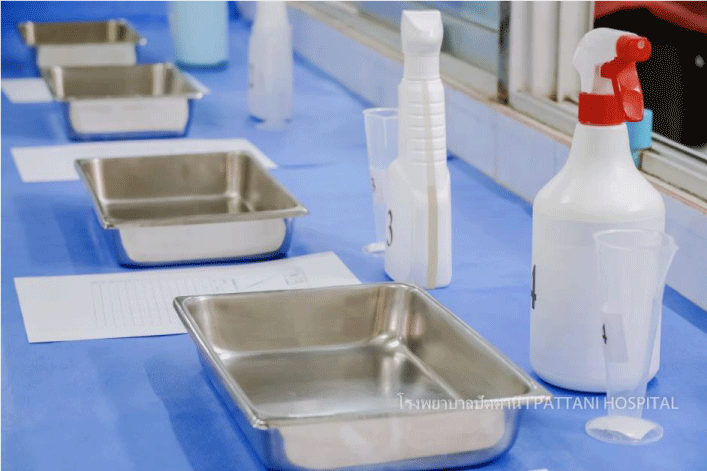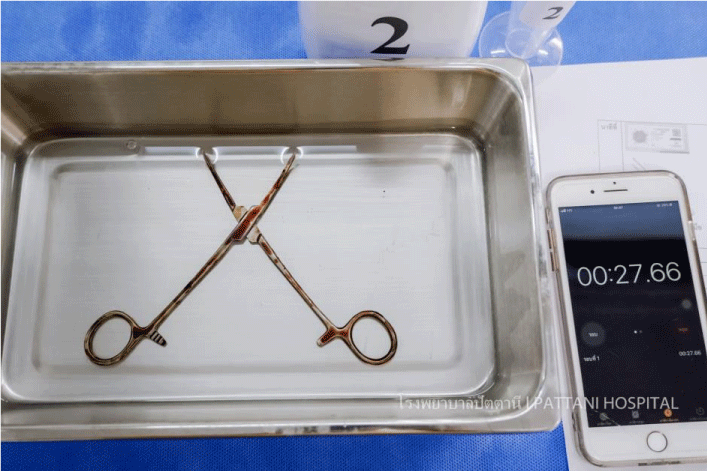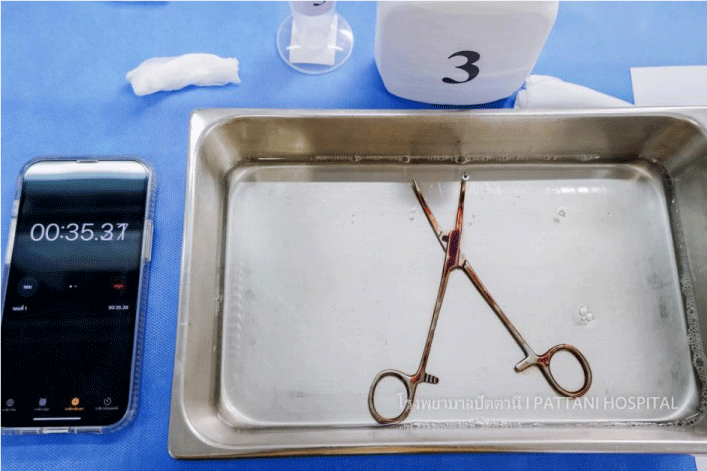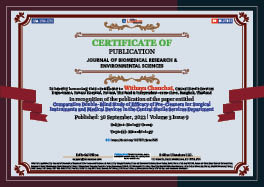Biology Group . 2022 September 30;3(9):1125-1127. doi: 10.37871/jbres1565.
Comparative Double-Blind Study of Efficacy of Pre-Cleaners for Surgical Instruments and Medical Devices in the Central Sterile Services Department
Chanitsara Jindarat and Withaya Chanchai*
- Instrument pre-cleaning spray
- Instrument pre-cleaning foam
- Blood stains
- Medical devices
Abstract
The Central Sterile Supply Department (CSSD) is one of the hospital's critical support services. It is a place to receive medical equipment blood-stained from the other departments to be cleaned. It is responsible for cleaning, receiving, storing, sterilizing, and returning medical equipment to everyone and delivered to different departments within the hospital. Nowadays, various cleaning and dissolving blood stains are used to clean and remove blood stains. This research aimed to compare the efficacy of pre-cleaning spray and pre-cleaning spray foam cleaners for blood-contaminated surgical instruments and medical devices in the Central Sterile Services Department. The pre-cleaning spray was significantly higher than the pre-cleaning spray foam (p ≤ .005). A significant difference in the 2-minute pre-cleaning spray was observed by using cleaning indicators. The pre-cleaning spray foam started dissolving blood after 5 minutes. Therefore, from the study, using the pre-cleaning spray for dissolving blood stains and pre-cleaning has a more practical effect than pre-cleaning foam.
Introduction
Central Sterile Supply Department (CSSD) is one of the important supportive services in the hospital which ensures an infection-free atmosphere [1]. The cleaning and dissolving of blood stains to clean and remove blood stains were currently divided into two types: pre-cleaning spray and pre-cleaning spray foam. Several research and clinical studies have assessed reprocessing-related issues in pre-cleaning and reusable devices such as surgical instruments, anesthetic devices, and endoscopes [2,3]. Therefore, cleaning is the first step to dispersing blood stains on the apparatus and is essential to promote a more efficient cleaning procedure in various rinsing methods. This research aimed to compare the efficacy of pre-cleaning spray and pre-cleaning spray foam cleaners for blood-contaminated surgical instruments and medical devices. In addition, there was a double-blind comparative study on the use of each type of detergent.
Methods
This study was conducted at a be carried out during a period of three months in the year 2022 at the Central Sterile Services Department (CSSD) of Pattani Hospital. The experiment was conducted by preparing 160 samples. The efficacy of four brands of pre-cleaners with different structural formulas is compared during a double-blind, randomized controlled trial. The pre-cleaners used in this study are Medical Enzyme Detergent Spray RTU, Pre-Cleaning Spray based on Mangosteen extract (Garcinia mangostana L and Ethoxylated Alcohol, Foaming disinfectant spray for instrument pre-treatment, and Multi Enzyme Pre-Cleaning Instrument Spray Foam (Figure 1). Each product’s brand and the manufacturer will not be informed to healthcare workers. Four healthcare workers in the CSSD prepared the same medical device that was contaminated with blood stains for 40 samples per person. They performed the same experiment with 40 samples and recorded their results. Healthcare workers measure the 100 CC solution of each brand in the bath. The experiment used a medical device with bloodstains placed in four baths with different solutions, and bloodstained reaction test strips were set. The contact time for the removal of blood stains on medical devices was tested by cleaning indicators at the following times: 1, 2, 3, 4, 5, 10, 15, 20, 25, and 30 minutes (Figures 2-5).
Results
The pre-cleaning spray was significantly higher than the pre-cleaning spray foam (p ≤ .005). A significant difference in the 2-minute pre-cleaning spray was observed by using cleaning indicators. The pre-cleaning spray foam started dissolving blood after 5 minutes. There was a statistically significant difference in blood dissolution time between Medical Enzyme Detergent Spray RTU and Pre-Cleaning Spray based on Mangosteen extract (Garcinia mangostana L and Ethoxylated Alcohol) (p ≤ .005). There was a statistically significant difference in the time comparison of blood dissolution between Foaming disinfectant spray for instrument pre-treatment and Multi Enzyme Pre-Cleaning Instrument Spray foam (p ≤ .005). In addition, from 20 minutes onwards, some products will react with blood stains.
Conclusion
The finding of this study shows that pre-cleaning spray takes a short time to break down blood stains. These results also show that contact time, followed by removal of blood stains of spray and foam in the instruments, resulted in time measurements of 2 minutes and five that were similar. This is consistent with studies of the reprocessing procedure for medical devices must be available as a standard operating procedure and describe the following steps: pre-cleaning (if applicable), cleaning (possibly two times), disinfection, drying, functional testing, packaging, sterilization (if applicable), labeling, release, transport, storage of sterile supplies [4,5].
Acknowledgment
This study was supported by Healthmedic Innovation Academy, Bangkok, Thailand. Special thanks are owed to all participants in the Central Sterile Services Department (CSSD) of Pattani Hospital, Thailand.
References
- Amrita Shriyan, Ashvij Shriyan. A Study On The Efficiency Of CSSD At A Health Care Centre TJPRC. Journal of Nursing and Patient Safety & Care. 2015;1(2);7-16.
- Rutala WA, Gergen MF, Weber DJ. Efficacy of a washer-disinfector in eliminating healthcare-associated pathogens from surgical instruments. Infect Control Hosp Epidemiol. 2014 Jul;35(7):883-5. doi: 10.1086/676867. Epub 2014 May 20. PMID: 24915220.
- Asima Banu, Subhas GT. Central Sterile Supply Department –Need Of The Hour. J Pub Health Med Res. 2013;1(2):58-62
- Exner M, Bhattacharya S, Gebel J, Goroncy-Bermes P, Hartemann P, Heeg P, Ilschner C, Kramer A, Ling ML, Merkens W, Oltmanns P, Pitten F, Rotter M, Schmithausen RM, Sonntag HG, Steinhauer K, Trautmann M. Chemical disinfection in healthcare settings: critical aspects for the development of global strategies. GMS Hyg Infect Control. 2020 Dec 23;15:Doc36. doi: 10.3205/dgkh000371. PMID: 33520601; PMCID: PMC7818848.
- Kapoor A, Vora A, Nataraj G, Mishra S, Kerkar P, Manjunath CN. Guidance on reuse of cardio-vascular catheters and devices in India: A consensus document. Indian Heart J. 2017 May-Jun;69(3):357-363. doi: 10.1016/j.ihj.2017.04.003. Epub 2017 Apr 13. PMID: 28648434; PMCID: PMC5485387.
Content Alerts
SignUp to our
Content alerts.
 This work is licensed under a Creative Commons Attribution 4.0 International License.
This work is licensed under a Creative Commons Attribution 4.0 International License.













